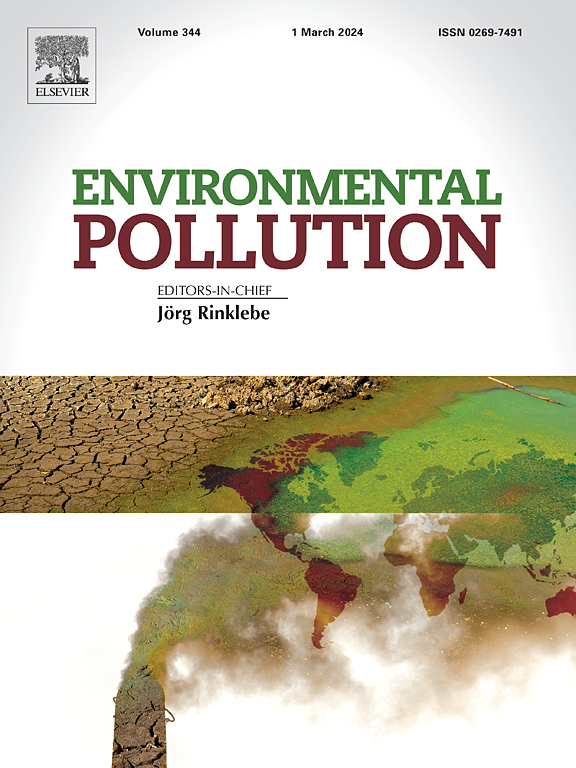利用地理-人工智能建模方法评估超细颗粒的三维变异性:以台湾竹南苗利为例
IF 7.6
2区 环境科学与生态学
Q1 ENVIRONMENTAL SCIENCES
引用次数: 0
摘要
以前的空气污染模型研究主要强调水平分布,忽视了城市环境中污染物浓度的垂直变化。因此,空气污染物的三维(3-D)行为,特别是超细颗粒物(PM0.1),没有充分表征。本文研究了台湾省苗利市竹南和土坟地区PM0.1的三维分布。使用六旋翼无人机,在海拔40、60和100 m的12个地点测量PM0.1浓度。开发了一个地理空间-人工智能(Geo-AI)模型来估计三维PM0.1浓度,将土地利用、气象和三维建筑数据等数据库作为预测变量。SHapley加性解释(SHAP)分析表明,建筑高度、温度、二氧化碳、一氧化氮、森林覆盖率和与建筑物的三维空间距离是主要的预测因子。五种机器学习算法被用于建模。极端梯度增强回归器(XGBR)的训练R2为0.98,表现最佳。通过10倍交叉验证和分层验证进一步检验了模型的稳健性,结果显示R2值超过0.85,表明该模型具有较强的捕捉不同环境条件下PM0.1空间变化的能力。这些研究结果强调了垂直污染物扩散在城市环境中的关键作用,以及将详细的三维测量纳入城市规划和公共卫生政策的必要性。本文章由计算机程序翻译,如有差异,请以英文原文为准。

Assessing 3-D Variability of Ultrafine Particle Using a Geo-AI Modelling Approach: A Case Study in Zhunan-Miaoli, Taiwan
Previous air pollution modeling studies have predominantly emphasized horizontal distributions, overlooking the critical vertical variability of pollutant concentrations in urban environments. Therefore, the three-dimensional (3-D) behavior of air pollutants, and of ultrafine particulate matter (PM0.1) in particular, is insufficiently characterized. This study examined the 3-D distribution of PM0.1 in the Zhunan and Toufen regions in Miaoli, Taiwan. Using a hexacopter drone, PM0.1 concentrations were measured at 12 locations, at altitudes of 40, 60, and 100 m. A geospatial-artificial intelligence (Geo-AI) model was developed to estimate 3-D PM0.1 concentrations, incorporating databases such as land use, meteorology, and 3-D building data as predictor variables. SHapley Additive exPlanations (SHAP) analysis for variable selection showed that key predictors were building height, temperature, carbon dioxide, nitric oxide, forest coverage and 3-D spatial distance from buildings. Five machine learning algorithms were used for modeling. Extreme Gradient Boosting Regressor (XGBR) achieved the best performance with a training R2 of 0.98. The model’s robustness was further examined through 10-fold cross-validation and stratified validation, which yielded R2 values exceeding 0.85, indicating a strong ability to capture the spatial variation of PM0.1 across different environmental conditions. These findings underscored the crucial role of vertical pollutant dispersion in urban environments and the need to incorporate detailed 3-D measurements into urban planning and public health policies.
求助全文
通过发布文献求助,成功后即可免费获取论文全文。
去求助
来源期刊

Environmental Pollution
环境科学-环境科学
CiteScore
16.00
自引率
6.70%
发文量
2082
审稿时长
2.9 months
期刊介绍:
Environmental Pollution is an international peer-reviewed journal that publishes high-quality research papers and review articles covering all aspects of environmental pollution and its impacts on ecosystems and human health.
Subject areas include, but are not limited to:
• Sources and occurrences of pollutants that are clearly defined and measured in environmental compartments, food and food-related items, and human bodies;
• Interlinks between contaminant exposure and biological, ecological, and human health effects, including those of climate change;
• Contaminants of emerging concerns (including but not limited to antibiotic resistant microorganisms or genes, microplastics/nanoplastics, electronic wastes, light, and noise) and/or their biological, ecological, or human health effects;
• Laboratory and field studies on the remediation/mitigation of environmental pollution via new techniques and with clear links to biological, ecological, or human health effects;
• Modeling of pollution processes, patterns, or trends that is of clear environmental and/or human health interest;
• New techniques that measure and examine environmental occurrences, transport, behavior, and effects of pollutants within the environment or the laboratory, provided that they can be clearly used to address problems within regional or global environmental compartments.
 求助内容:
求助内容: 应助结果提醒方式:
应助结果提醒方式:


